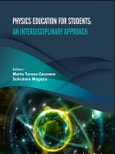Physics Education for Students: An Interdisciplinary Approach is a compilation of reviews that highlight new approaches and trends in teaching and learning specific topics on physics to high school and university students. The reviews cover different areas of physics education (laboratory activities, mathematics, philosophy and history) and the ways that learning outcomes can be improved. These distinguished areas can generate complexities and difficulties for students in learning some concepts since the same topics are often presented while following approaches that do not highlight the existing correlations among the involved disciplines. The reviewers discuss an integrated framework for readers with the objective to promote the inclusion of specific laboratory activities and mathematics contents for physics courses addressed to university students, with evidence of the importance of combining a historical and philosophical approach as well. Specific topics in this book include the benefits of active learning in physics education, dialogic best practices in science education, research-based proposals on optical spectroscopy in secondary schools, didactic principles and e-learning in physics and expansive framing in physics laboratories.
Physics Education for Students: An Interdisciplinary Approach, with its selection of expert reviews is an interesting read for academics and researchers involved in STEM education, at the school or college level.
Physics Education for Students: An Interdisciplinary Approach, with its selection of expert reviews is an interesting read for academics and researchers involved in STEM education, at the school or college level.
Table of Contents
Chapter 1 Expansive Framing Produces More Vivid Introductory- Physics Labs
- Danny J. Doucette and Chandralekha Singh
- Introduction
- Physics Labs
- Biomedical Applications
- Nature of Science
- Conclusion
- Consent for Publication
- Conflict of Interest
- Acknowledgements
- References
Chapter 2 Active Learning in Studying Physics as the First Research
- Experience of University Students
- Introduction
- Organization of Project Activities in Physics
- Involving Students in Performing a Demonstration Experiment in Physics
- Students’ Preparation for Seminar Presentations on the Topics That Require Physical
- Demonstrations
- Students’ Development of Working Models of Devices That Demonstrate Physical
- Phenomena and Processes
- Students’ Research on Physical Topics
- Organization of Interdisciplinary Project Work
- Conclusion
- Consent for Publication
- Conflict of Interest
- Acknowledgements
- References
Chapter 3 Can Physics Education Support a Self-Responsible Society?
- Gilbert Ahamer
- Introduction
- Physics Labs First Didactic Method “3×7 = 21”
- Didactic Basics of the Course Design “3×7 = 21”
- Considering Several Value Systems Means an Inter-Paradigmatic Approach
- The Concrete Didactic Process of “3 X 7 = 21”
- Reflection of the “3 X 7 = 21” Process
- Web Design for “3 X 7 = 21”
- Second Didactic Method: The Jet Principle in E-Learning
- Introduction and Motivation for the “Jet Principle”
- Understanding the Design of the “Jet Principle”
- Inventing a “Jet Engine” for Smoothing Learning Processes
- Symbolic Interpretation of the Analogy with a Jet Engine
- Elena Kazakova, Svetlana Kirpu, Marina Kruchek, Elena Moshkina, Olga Sergeeva Dqg
- Elena Tikhomirova
- The “Jet Principle” in (E-)Learning
- Description of the “Jet Principle” Process
- Summary of the “Jet Principle” Process
- Web Design for the “Jet Principle” in E-Learning
- Conclusions
- Consent for Publication
- Conflict of Interest
- Acknowledgements
- References
Chapter 4 Dialogic Best Practice for Dissemination of a Scientific
- Culture
- Gilbert Ahamer
- Surfing Global Change
- Pedagogic Foundation of the Negotiation Game “Surfing Global Change”
- Interdisciplinarity
- A Variety of Value Systems: Becoming Interparadigmatic
- The Rules for the Game “Surfing Global Change”
- Overview of the Game “Surfing Global Change”
- Basics of Web Design for Sgc
- Conclusions
- Consent for Publication
- Conflict of Interest
- Acknowledgements
- References
Chapter 5 Research-Based Proposals on Optical Spectroscopy in Secondary School
- Daniele Buongiorno and Marisa Michelini
- Introduction
- The Research Perspective
- The General Structure of the Educational Path
- Context, Sample and Methodology
- Data Analysis
- Masterclass(C) Experimentation: Post-Test
- Summer School Experimentation: Pre- and Post-Test
- Conclusions
- Consent for Publication
- Conflict of Interest
- Acknowledgements
- References
Chapter 6 Normal Mode Investigation of a System of Coupled
- Oscillators: a Physics Lecture
- Introduction
- Theoretical Background
- Experimental Set-Up
- Experimental Procedure
- Experimental Data
- Data Analysis
- Historical Background: Fourier and Wavelet Transforms
- Application of Fourier and Wavelet Transforms
- Concluding Remarks
- Consent for Publication
- Conflict of Interest
- Acknowledgements
- References
Author
- Maria Teresa Caccamo
- Salvatore Magazù








